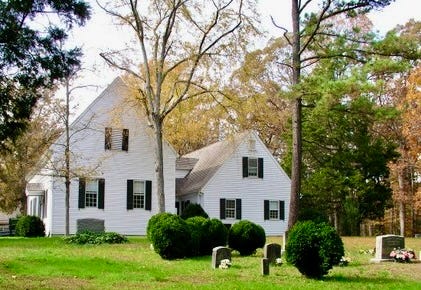
Previously on Unsettled
Bacon’s Rebellion began to fray when Nathaniel Bacon suddenly died. Then British troops showed up and put an end to the whole mess. The old governor had the rebel leaders hanged, a violation for which he was recalled to England where he also died. As for John Kimbrough, who fought for the British, afterwards claimed his pension then got back to business in New Kent, Virginia.
Part 1, No. 6
The Nature of a Settler
John Kimbrough proved to be the ideal founding father in our family’s origin story. He was by nature restless and single-minded—traits that routinely resurface in subsequent generations. Kimbrough descendants are as quick to pull up stakes, as they are to drive them into new ground—in the Appalachian hills, on the frontier, and on the streets of California. In every case, these lands once belonged to Natives. Our family’s story, for good or ill, is about the itch to move on.
John Makes a Name for Himself
Then Mary Douglas Kimbrough died. Like many women of child-bearing age, she died young, at 35, leaving behind her husband and six children, the youngest three years old. John devoted the next seven years to caring for his children—and to acquiring more land.
John’s ambition dovetailed nicely with the needs of the colonial government. For him, prosperity meant property, and Virginia’s government was offering land in exchange for recruiting immigrants and paying their passage to settle in the colony. Under this collaboration, he made recruiting forays to England, Scotland and Ireland, and with each successful trip, added to his land holdings. It was said that Kimbrough was so successful that he came to be known as “The Colonist,”a name he may have coined himself. On one trip, for example, he recruited a group of Scots, described as “former neighbors” and their children, for which he received 100 acres for each head of household. In 1687 he received 575 acres for recruiting nine Scots citizens to settle in Virginia.
A Treaty Broken-ish
The British government’s generous distribution of free land to new colonists was made possible because the Crown had taken these lands from Native Americans in the first place.The British claimed these lands under what they considered as their right under colonization. In fact Native American tribes had occupied the lands for centuries. The area known as Pamunkey Neck, for example, was the original home of the Pamunkey Indians who had fought off the British time and again over thirty years.
However, in 1677 both sides agreed to a peace treaty to end the hostilities. Under its terms, the British created the Pamunkey Reservation and agreed to protect the Pamunkey from “all enemies.” The British government, though, retained control of the reservation and banned white settlement on the lands. Later, when the British gave the Pamunkey title to these lands, white settlers skirted the ban by persuading the Pamunkey to lease the lands to them. Eventually, the tribe began selling these lands to white lease-holders, one of whom was John Kimbrough.
The question of the legality of such lease-to-ownership deals landed Kimbrough in court before the Virginia House of Burgesses. He and his business partners had first leased, then purchased 1,500 acres of land located on Pamunkey Neck. The Virginia House of Burgess eventually ruled that since the Pamunkey owned title to the land they were within their rights to sell the lands to Kimbrough and his partners. However, all records of these transactions were lost in a fire that destroyed Virginia’s early deed records. At some point the Pamunkey did regain rights to their land, which today is a 1,200-acre reservation on Pamunkey Neck.
John Takes a Wife
John’s service in Governor William Berkeley’s militia, as well as his status as a landowner, won him entry into the governor’s social circle. The governor’s 17-year-old relative Margaret Berkeley socialized in this circle of Virginia’s elite. The teenager undoubtedly drew the attention of many an admirer, including the 47-year-old-widower John Kimbrough. Age difference aside, they soon married. Over the course of their long marriage, the couple would add six more children to the Kimbrough clan. In addition to his business and family responsibilities, John was a leader in the community. He served on the governing board of the Episcopal Church where he was instrumental in building St. Paul’s Episcopal Church. He donate the land and timber for the church. During its construction, the enterprising leader rented out part of his house to the parish for church services.
John Kimbrough was 76 when he died at his home in the spring of 1716. However, with his death most of what we know of his (and Mary’s) life also was lost. The”Maryland Merchant” ship, on which they sailed to America, listed the number of guns on board (40), but not the names of its passengers. Most of Kimbrough’s official documents, including land and church records, were he destroyed by a series of fires, first during the Revolutionary War and finally during the destruction of the Civil War.
There are no tombstones to mark the graves of John and Mary. Still, the Kimbrough name lives on throughout America. Kimbrough descendants, true to their robust Scots lineage, were long-lived and stunningly prolific. Kimbrough himself fathered 14 children, while John II and his wife Nancy had 10 offspring. Each successive generation averaged a dozen or so children. Kimbrough sons and daughters also married into families—the Murphys, the Martins and the McKinzies—who proved to be as antsy as John Kimbrough was in his day.




